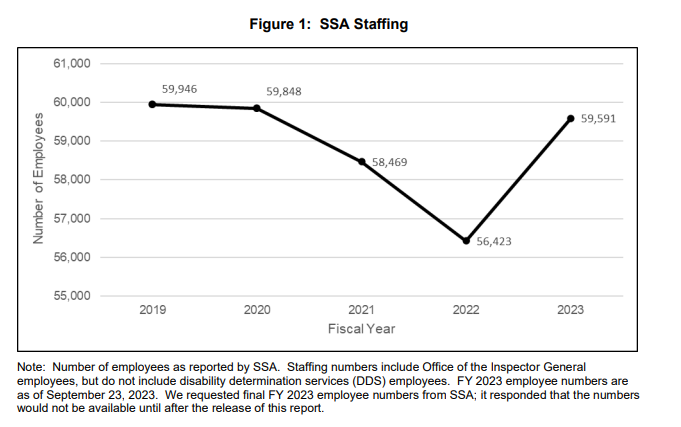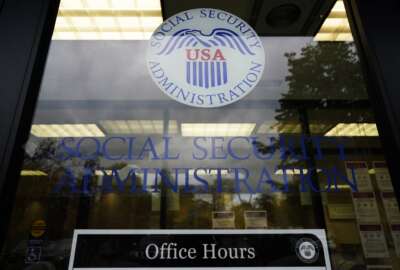An ‘agency in crisis’: Union makes pitch for $20B supplemental funding for SSA
The $20 billion supplemental funding request for SSA over the next 10 years would be crucial to reach the quality of services that the public expects, the American...
To try to address service and workforce challenges at the Social Security Administration, the American Federation of Government Employees is calling on Congress for a massive funding influx for the agency over the next decade.
The combination of a growing beneficiary population with stagnating staffing numbers is contributing to significant backlogs and delays in Social Security services, said AFGE, the federal union that represents tens of thousands of frontline SSA employees.
“Baby boomers are turning age 65 at a rate of 10,000 a day and the number of beneficiaries is rapidly increasing, yet slashed budgets for SSA have meant the loss of 10,000 workers,” AFGE said in its funding proposal. “Cuts from the continuing resolution are forcing SSA to suspend new hires and limit overtime.”
The union is calling for $20 billion in supplemental funding for SSA over the next 10 years. While the requested number is large, AFGE Council 220 President Jessica LaPointe said it’s necessary to reach the quality of services that the public expects.
“This is above and beyond anything that you would get in appropriations,” LaPointe said during a Social Security forum Wednesday. “But that would allow SSA to revitalize beyond this limitation on administrative expenses that they keep [getting]. You have to infuse the appropriate amount of resources into a government agency to get it operational and running properly. Without that funding, we’re going to be in this same position, year after year, of just barely meeting the public’s needs, if at all.”
About $2.5 billion of AFGE’s proposal would go toward staffing up the agency, aiming to reach levels not seen since 2010. Another $3.2 billion would give the SSA workforce more benefits in an effort to retain the employees.
“This would allow SSA to provide the help with childcare and student loans that nearly every other federal agency offers, reinstate a popular vision assistance program for employees who suffer from using agency equipment, improve mental health support, and increase transit and parking subsidies to cover employee costs more effectively,” AFGE said.
Additionally, $3 billion would be put toward technology modernization and another $2 billion would fund better security at field offices nationwide, according to the union’s proposal.
Supplemental funding could also help with overpayments that SSA makes. Increasing resources to be able to hire more staff members would help directly mitigate the issue, both stakeholders and SSA leadership have said. Over the past two years, SSA overpaid about 2 million beneficiaries.
“The push for a supplemental funding to SSA is novel, and super powerful,” said Alex Lawson, executive director of Social Security Works, during the forum. “If you put more money into the agency, in a strategic manner, then you can actually prevent overpayments — it really does pay for itself.”
The idea for SSA would be very similar to the recent supplemental IRS funding, Lawson said. The IRS has seen customer service improvements after beginning to use a supplemental funding package from Congress. In 2023, that funding was cut down to $60 billion as part of debt ceiling negotiations. But the IRS has hired thousands more employees in just the last year — and plans to add 20,000 total to its workforce over the next couple years.
The road to improvement, of course, isn’t perfect. Despite the progress, the IRS is still struggling to hire qualified candidates in some key areas.
At the same time, agencies are currently facing the potential of a full-year continuing resolution or a possible government shutdown.
Still, for SSA, expanding the workforce and improving workplace conditions will be central to reaching a higher quality of services, many — including top agency leadership — have said. Currently, backlogs in disability determination services and delays in customer service are driven by limited staffing and legacy technology.
“We feel that squeeze of the frustrated customer who cannot get benefits timely, who are waiting over seven months without income to get a disability decision, who are waiting almost an hour to get through to an agent on a failing 1-800 number,” LaPointe said. “This is by no means the fault of the hardworking customer service representative or the claims specialist or the Social Security worker. This is all a result of underfunding.”
Many of those currently working at SSA experience poor work-life balance, burnout, stress and other factors that are causing some to consider leaving their jobs. Last year, the agency came in very last place of the 17 large agencies in the Best Places to Work rankings from the Partnership for Public Service.
Social Security staffing levels, after taking a nosedive in 2022, have rebounded, according to a report from SSA’s inspector general (IG) office. Hiring during fiscal 2023 helped SSA reverse the recent trend of declining employees in more recent years, a November 2023 IG report said.

The rebound came after OPM gave SSA direct hire authority for its frontline positions. The authority allowed SSA to double its hiring pace in 2023, hiring more than 600 employees per month, compared to about 300 per month in 2022, the IG report said. SSA hired a total of 7,800 employees in fiscal 2023, but after factoring in retirements and attrition, the agency’s headcount only increased by about 3,200 employees. SSA currently has about 60,000 employees.
“Hiring more employees and better distributing employee workloads helped address overwork as a cause of attrition,” the IG report said.
Workforce issues remain a major management challenge for SSA. The agency still struggles with sufficient funding, employee development and retention, and an anticipated retirement wave, the IG report said. Right now, 13% of SSA’s workforce is eligible to voluntarily retire, and 12% are eligible for early retirement. Three years from now, 20% of SSA’s employees will be eligible to voluntarily retire, and 15% will be able to retire early.
“SSA recognizes the loss of technical and institutional knowledge through employee attrition is one of its greatest challenges,” the IG report said.
At the same time, SSA will need to develop a clear human capital plan — something it does not currently have — to be able to effectively use its resources and drive improvements, the IG report said.
But in just the past few months, “we’ve seen a few signs of a sea change,” AFGE’s LaPointe said.
SSA has brought on board Martin O’Malley, former governor of Maryland and former mayor of Baltimore, as its new permanent commissioner. The Senate confirmed O’Malley to the position in December, and he subsequently took over for former Acting Commissioner Kilolo Kijakazi.
“Currently, Commissioner O’Malley is traveling to visit and talk with SSA employees in all 10 of our regions across the country, asking for their input and ideas about improving customer service,” SSA Press Officer Mark Hinkle said in an email to Federal News Network. “He is focused on meeting and hearing from as many employees as possible.”
In those discussions, O’Malley is focused on hearing from employees about burnout, attrition, work-life balance as well as how to best address customer service issues and delays, Hinkle added.
So far, LaPointe said O’Malley’s leadership, as well as his experience, appears to be helping the agency head in the right direction.
“He has been able to turn failing government systems around and is a subject matter expert on it,” LaPointe said. “He understands the appropriate use of a data driven narrative and being transparent with the data with all the stakeholders to show, ‘this is where we’re at, and this is where we need to go.’”
Copyright © 2025 Federal News Network. All rights reserved. This website is not intended for users located within the European Economic Area.
Drew Friedman is a workforce, pay and benefits reporter for Federal News Network.
Follow @dfriedmanWFED






